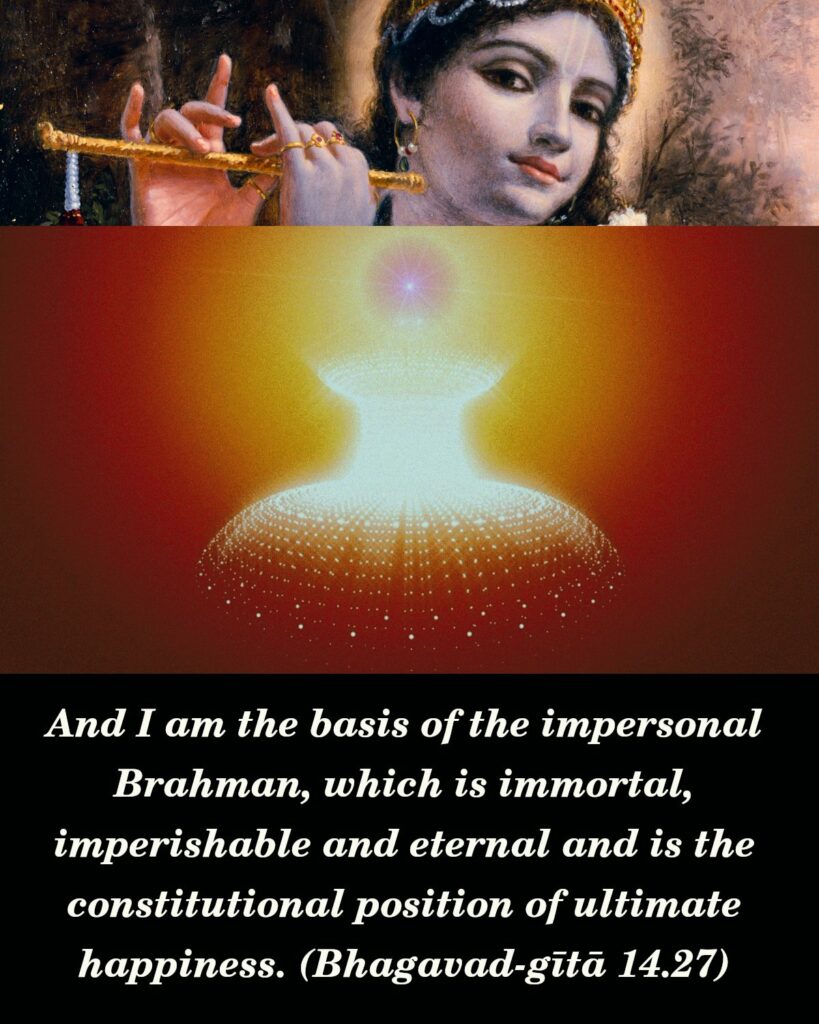ब्रह्मणो हि प्रतिष्ठाहममृतस्याव्ययस्य च |
शाश्वतस्य च धर्मस्य सुखस्यैकान्तिकस्य च || 27||
brahmaṇo hi pratiṣhṭhāham amṛitasyāvyayasya cha
śhāśhvatasya cha dharmasya sukhasyaikāntikasya cha
brahmaṇaḥ—of Brahman; hi—only; pratiṣhṭhā—the basis; aham—I; amṛitasya—of the immortal; avyayasya—of the imperishable; cha—and; śhāśhvatasya—of the eternal; cha—and; dharmasya—of the dharma; sukhasya—of bliss; aikāntikasya—unending; cha—and
Translation:
For I am the Abode of Brahman, the Immortal and the Immutable, and of the Eternal Dharma, and of Absolute Bliss.
Commentary:
Having declared that His devotee crosses the three Gunas and attains Paramatma, the Lord here reveals his true nature as the Supreme Brahman Himself. Lord Krishna, the teacher of the Gita is not a mortal, but Paramatma Himself, the Supreme Brahman. Sri Krishna is not simply the son of Yasoda, the cow-herd boy of the Brindavan, He is verily Paramatma. He is the eternal Dharma; He is bliss Absolute; He is the Immortal and the Immutable. Therefore who worships Him with undivided mind, by the law (Yadbhavam tadbhavati) – that man becomes That which he contemplates, transcends the Gunas and becomes one with the Lord. What is that Paramatman? The Lord explains by three attributes :
- That is Immortal (deathless and therefore birthless); That is Immutable (unchanging).
- That is eternal Dharma;
- That is bliss absolute.
By the first (Immortality and Immutability), the ‘sat’ aspect of Brahman is stated; by the second (Eternal Dharma), the ‘chit’ aspect of Brahman is stated; and by the third (Bliss absolute), and ‘ananda’ aspect of Brahman is stated. Thus the Lord declares that He is Brahman, Existence Absolute, Knowledge Absolute, and Bliss (Ananda) Absolute.
For the sake of easy forms of worship, the Lord appears as the son of Yasoda, as the Cow-herd boy of Brindavan, as the lover of the Gopis, as the Charioteer of Arjuna (Parthasarathi) and in a hundred other detectable forms. He, the Lord, is again all the ‘Avataras’. He is Rama, the son of Dasaratha; He is Narasimha, the destroyer of Hiranyakasipu and the saviour of Prahlada; He is Vamana; He is all this Universe, and all its spectacular manifestations. There is nothing beyond Him. He is all. The devotees should always remember that whatever form they may worship, the Lord is the supreme Sachidananda Brahman.
By this verse, Dualism, Qualified monism and Advaita are declared to be One in the end. The end is the same though the means are different. The Lord whom the Dualists worship as the repository of all blessed qualities (Ananta kalyana gunabhirama) is not different from the Brahman of the sages. While the ‘Sat’ aspect of Brahman is common to both, the devotee emphasises the ‘ananda’ aspect of Brahman, and the Jnani the ‘chit’ aspect. But it is declared here that ‘Chit’ (Knowledge) is not separate or distinct from Ananda’ (bliss). There is no essential difference between Jnana and Bhakti; for, both types of sadhana culminate in the realisation of the Supreme. Each man can choose his own method and form of worhsip and reach the goal.
Question: Who is Lord Krishna?
Answer: He is the Supreme Brahman.
Question: What is the nature of Brahman?
Answer:
- Immortal and Immutable (Sat).
- Eternal ‘Dharma’ (Chit)
- Bliss Absolute (Ananda).
Bhagavad Gita: Chapter 14 🔻 (27 Verses)
